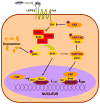What do mechanotransduction, Hippo, Wnt, and TGFβ have in common? YAP and TAZ as key orchestrating molecules in ocular health and disease
- PMID: 23792172
- PMCID: PMC3795947
- DOI: 10.1016/j.exer.2013.06.012
What do mechanotransduction, Hippo, Wnt, and TGFβ have in common? YAP and TAZ as key orchestrating molecules in ocular health and disease
Abstract
Cells in vivo are exposed to a complex signaling environment. Biochemical signaling modalities, such as secreted proteins, specific extracellular matrix domains and ion fluxes certainly compose an important set of regulatory signals to cells. However, these signals are not exerted in isolation, but rather in concert with biophysical cues of the surrounding tissue, such as stiffness and topography. In this review, we attempt to highlight the biophysical attributes of ocular tissues and their influence on cellular behavior. Additionally, we introduce the proteins YAP and TAZ as targets of biophysical and biochemical signaling and important agonists and antagonists of numerous signaling pathways, including TGFβ and Wnt. We frame the discussion around this extensive signaling crosstalk, which allows YAP and TAZ to act as orchestrating molecules, capable of integrating biophysical and biochemical cues into a broad cellular response. Finally, while we draw on research from various fields to provide a full picture of YAP and TAZ, we attempt to highlight the intersections with vision science and the exciting work that has already been performed.
Keywords: TAZ; TGFβ; Wnt; YAP; biophysical cueing; hippo; mechanotransduction.
Copyright © 2013 Elsevier Ltd. All rights reserved.
Figures






Similar articles
-
Regulation of YAP/TAZ Activity by Mechanical Cues: An Experimental Overview.Methods Mol Biol. 2019;1893:183-202. doi: 10.1007/978-1-4939-8910-2_15. Methods Mol Biol. 2019. PMID: 30565135 Review.
-
[Role of Hippo-YAP/TAZ signaling pathway in mechanotransduction.].Clin Calcium. 2016;26(12):1751-1756. Clin Calcium. 2016. PMID: 27885187 Japanese.
-
Role of extracellular matrix and YAP/TAZ in cell fate determination.Cell Signal. 2014 Feb;26(2):186-91. doi: 10.1016/j.cellsig.2013.11.006. Epub 2013 Nov 9. Cell Signal. 2014. PMID: 24216612 Review.
-
Dysfunctional Mechanotransduction through the YAP/TAZ/Hippo Pathway as a Feature of Chronic Disease.Cells. 2020 Jan 8;9(1):151. doi: 10.3390/cells9010151. Cells. 2020. PMID: 31936297 Free PMC article. Review.
-
Crosstalk between Hippo and TGFβ: Subcellular Localization of YAP/TAZ/Smad Complexes.J Mol Biol. 2015 Oct 23;427(21):3407-15. doi: 10.1016/j.jmb.2015.04.015. Epub 2015 May 1. J Mol Biol. 2015. PMID: 25937570
Cited by
-
Regulatory networks in mechanotransduction reveal key genes in promoting cancer cell stemness and proliferation.Oncogene. 2019 Oct;38(42):6818-6834. doi: 10.1038/s41388-019-0925-0. Epub 2019 Aug 12. Oncogene. 2019. PMID: 31406247 Free PMC article.
-
KTCNlncDB-a first platform to investigate lncRNAs expressed in human keratoconus and non-keratoconus corneas.Database (Oxford). 2017 Jan 10;2017:baw168. doi: 10.1093/database/baw168. Print 2017. Database (Oxford). 2017. PMID: 28077570 Free PMC article.
-
The Intersection of Mechanotransduction and Regenerative Osteogenic Materials.Adv Healthc Mater. 2020 Oct;9(20):e2000709. doi: 10.1002/adhm.202000709. Epub 2020 Sep 16. Adv Healthc Mater. 2020. PMID: 32940024 Free PMC article. Review.
-
The actin-binding protein EPS8 binds VE-cadherin and modulates YAP localization and signaling.J Cell Biol. 2015 Dec 21;211(6):1177-92. doi: 10.1083/jcb.201501089. Epub 2015 Dec 14. J Cell Biol. 2015. PMID: 26668327 Free PMC article.
-
Nanoporous gold as a neural interface coating: effects of topography, surface chemistry, and feature size.ACS Appl Mater Interfaces. 2015 Apr 8;7(13):7093-100. doi: 10.1021/acsami.5b00410. Epub 2015 Mar 2. ACS Appl Mater Interfaces. 2015. PMID: 25706691 Free PMC article.
References
Publication types
MeSH terms
Substances
Grants and funding
LinkOut - more resources
Full Text Sources
Other Literature Sources
Medical

